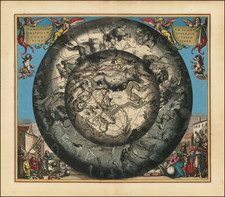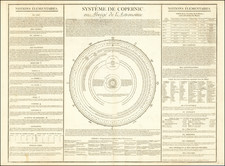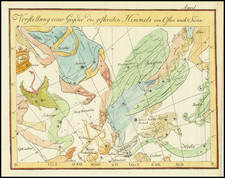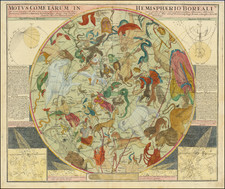A magnificent full-color example of Bayer's celestial chart of Piscis Austrinus, with the stars heightened in gold. Piscis Austrinus is the being that swallows the water poured by Aquarius and is an important constellation in several ancient civilizations. A recurring tale in Mediterranean cultures tells of the fish saving a heroine, in Egyptian mythology this is Isis. The two fish in Pisces are sometimes taken to be the offspring of this Piscis Austrinus.
The image is oriented so that the ecliptic line lies on the horizontal, just out of the range of the image. Other lines of cosmological importance are shown. The present example has no text on the verso. This work appeared in Bayer's Uranometria.
Bayer's Uranometria is one of the most important celestial atlases of the 17th century and the first modern star atlas. The atlas contained fifty-one star-charts, including forty-eight charts of the Ptolemaic constellations and two charts of the hemispheres. Bayer's constellation figures are based on the work of Jacobo de Gheyn.
The work was important for a number of reasons. Bayer introduced a new system of stellar nomenclature which used Greek and Roman letters to denote relative brightness in each constellation. In this system, the brightest stars were denoted with Greek letters, and the dimmest stars given Roman lettering. The resulting names persist to the present day (replacing Piccolomini's 1540 naming convention) and were of great help in standardizing the practice of astronomy. These letters were placed on the charts themselves, and also in a table that accompanied each chart. To provide an example of the system at work, the name of the brightest star in the constellation Taurus is now known as Alpha Tauri, with the second brightest star being Beta Tauri, and so forth. Further innovations in this work include each plate having a carefully engraved grid, so that star positions can be read off to fractions of a degree. These positions were taken from the catalog of Tycho Brahe's circulated manuscript prior to its 1602 publication. The Uranometria was also the first atlas to represent the stars of the southern latitudes as discovered to Europeans during Houtman's voyage to the East Indies in 1595.
Bayer's charts would be recognized as one of the four great celestial atlases. Almost all later atlases, including Bevis's, would be based heavily on his work. In addition, some scholars believe that the Uranometria influenced the works of scientists like Schiller and Kepler. In all, these are scientifically important and artistically stunning works, Bayer's charts are rarely offered separately on the market.

![[Piscis Austrinus] (Stars Heightened in Gold) By Johann Bayer](https://storage.googleapis.com/raremaps/img/small/83184.jpg)








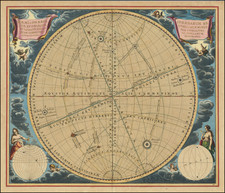
![(Cassini Moon Map) Atlas Céleste de Flamstéed, approuve par l'Académie Royale des Sciences, et publié sous le privilege de cette compagnie [with:] Reduction de la Grande Carte de la Lune de J. Dom. Cassini](https://storage.googleapis.com/raremaps/img/small/79182.jpg)
